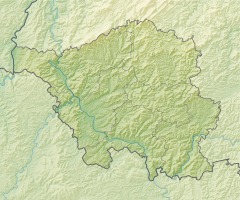Geislautern mine
| Geislautern mine | |||
|---|---|---|---|
| General information about the mine | |||
| Mining technology | Underground mining | ||
| Information about the mining company | |||
| Employees | 435 (1899) | ||
| Start of operation | around 1750 | ||
| End of operation | 1908 | ||
| Successor use | School, business | ||
| Funded raw materials | |||
| Degradation of | Hard coal | ||
| Geographical location | |||
| Coordinates | 49 ° 13 '48.9 " N , 6 ° 49' 23.6" E | ||
|
|||
| Location | Geislautern | ||
| local community | Völklingen | ||
| Regional Association ( NUTS3 ) | Saarbrücken | ||
| country | State of Saarland | ||
| Country | Germany | ||
| District | Saar | ||
The pit Geislautern is a former coal mine in Saarland Geislautern .
history
At the beginning of the 17th century, several residents of Geislautern asked Count Ludwig von Saarbrücken to be allowed to dig for hard coal on their property . Around 1730, two small private coal mines were in operation.
In 1750, Court Chamber Councilor Heus presented Prince Wilhelm Heinrich von Nassau-Saarbrücken with a plan to take over the mines in Nassau-Saarbrücken state property, which was implemented in 1751. In 1754 the prince ordered that no one was allowed to dig for coal privately, in return, from 1766 onwards, the county's residents were offered cheaper domestic coal . In 1773 seven miners were already working in the two tunnels of the Geislautern mine. In 1779 the annual output exceeded 1000 tons for the first time.
In 1797 the French government declared the Geislautern mine and ironworks in the county of Saarbrücken, which had been occupied since 1793, to the French state. In 1802 Napoleon decreed the establishment of a mountain and hut school in Geislautern, which in 1807 took over the Geislautern mine and ironworks . As a result, the Geislautern mining site became an important technology center, in which certain processes and machines were invented and tested.
In 1815 the Geislautern mine came into the possession of the Prussian state through the Second Peace of Paris and was incorporated into the iron and steel works. The coal was difficult to coke . 39 miners worked in the mine.
Between 1819 and 1822, tests were carried out on the " Friederiken-Eisenbahnweg " in the Frommersbachtal near Altenkessel to the Luisenthal coal loading point with a steam car from the Royal Iron Foundry in Berlin . It was supposed to be the first functioning locomotive to transport coal from the Bauernwald mine to the loading point on the Saar . The machine was designed and built in Berlin and shipped disassembled to the Saar. The assembly did not go well, the steam car never became fully functional and was sold as scrap in the 1830s.
The Lauterbach tunnel was laid out in 1827. Meanwhile were seams , however, hardly be reached in depth, therefore the first production well was 1,833 at Rotweg drilled , reaching in 1838 the first civil sole . In the meantime, two steam engines have been operated in Geislautern , one for conveying and one for draining the mine. In 1850, 315 miners worked in Geislautern, but the number of workers steadily decreased over the next few years. In 1856 work began on further sinking the shaft. In 1860 202 miners were still working on the mine. In 1864 the second underground level was reached. In the same year the boiler of an underground steam engine exploded. In 1874 the canal tunnel was dug, which from 1876 onwards connected the Geislautern mine directly with the loading port on the Saar.
In the 1880s, extensive coal reserves were tapped through crosscuts, but because of numerous water ingresses, abandoned hanging seams were increasingly mined. In 1889, 435 men were again working on the mine. The Rossel shaft was started in 1899, from which the Velsen mine later emerged . The production of the mine increased sharply and in 1902 reached its highest level with more than 74,000 tons of hard coal.
On April 1, 1908, the new Mining Inspection XII was created from the Geislautern and Velsen pits . It was initially based in Fürstenhausen . A few months later, on December 1, 1908, the Geislautern mine was shut down due to a lack of profitability. Your daytime facilities at Rotweg were initially converted into dormitories for miners from the Velsen mine. In 1926, the French mine administration moved the management of Mining Inspection XII to these buildings.
In 1935, mining inspection XII was renamed the Geislautern coal mine to commemorate the old mine. After the Second World War , the French mine administration reintroduced the old name Berginspektion XII . In 1952, Inspection XII was renamed Grube West and the Püttlingen , Ensdorf , Griesborn and Velsen mines were managed from here . In 1967, the West Mine moved from Geislautern to Ensdorf. The state and the city acquired the former mining site and relocated today's Warndtgymnasium to the site. The old buildings served as classrooms for the grammar school for about seven years, until the buildings were demolished in February 1978. The school moved into newly constructed buildings.
literature
- Karl Heinz Ruth: Geislautern mine . Volume 4 of the series of tunnels and shafts in coal mining on the Saar . Saarbergwerke, 1987
- Ralf Banken: The industrialization of the Saar region 1815–1914 . Volume 2: Take-Off Phase and High Industrialization. 1850-1914. Franz Steiner Verlag, Stuttgart, 2003
- Literature on the Geislautern mine in the Saarland Bibliography
Web links
- History of Geislautern and the mine , voelklingen-im-wandel.de
- History of the Geislautern mine , saarlandbilder.net
